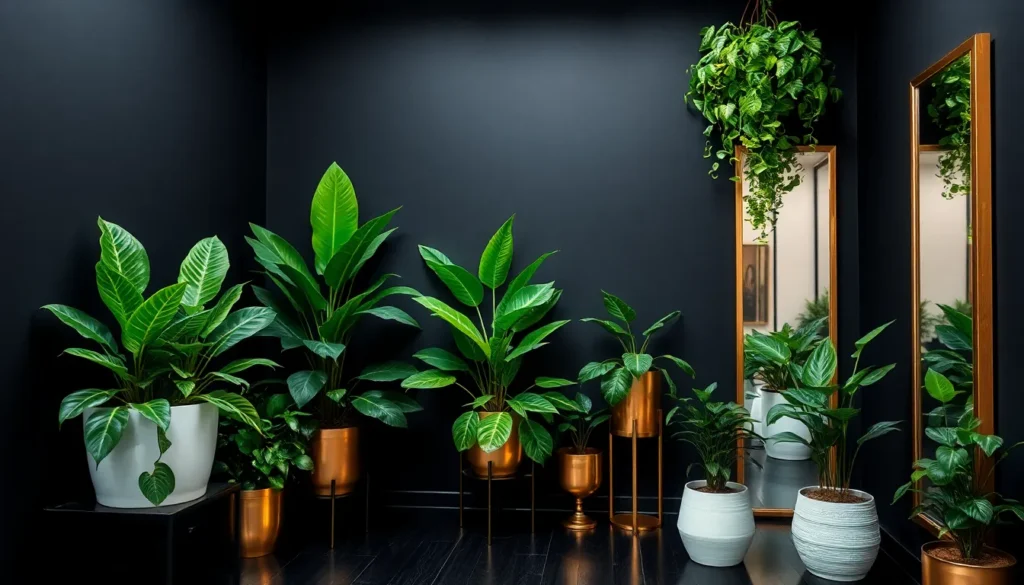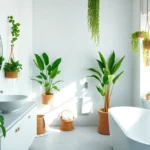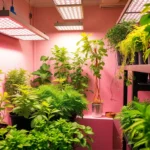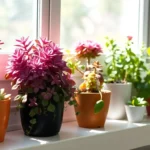Black rooms have become one of interior design’s most daring and sophisticated trends, and we’re here to show you why adding plants to these dramatic spaces creates pure magic. The bold contrast between dark walls and vibrant greenery doesn’t just look stunning—it transforms your entire living experience into something extraordinary.
We’ve discovered that plants actually thrive in black rooms more than most people realize. The dark backdrop makes every leaf pop with incredible intensity, while the moody atmosphere creates a sanctuary that’s both calming and energizing. It’s like bringing the mystery of a moonlit forest indoors.
Whether you’re designing a cozy reading nook or reimagining your entire living space, we’ll guide you through creating a black room with plants that’ll leave your guests speechless. Get ready to discover how this unexpected combination can revolutionize your home’s aesthetic and become your new favorite retreat.
Create a Dramatic Foundation with Matte Black Walls
Matte black walls serve as the perfect canvas for showcasing your plant collection’s natural beauty. We’ll guide you through selecting the ideal paint finish and coverage approach to maximize your black room’s dramatic impact.
Choose the Right Black Paint Finish
Matte finishes work best for creating depth in black rooms with plants because they absorb light rather than reflecting it. We recommend Benjamin Moore’s Black Beauty or Sherwin Williams’ Tricorn Black for their rich pigmentation and smooth application.
Flat paint finishes hide wall imperfections while creating a sophisticated backdrop that makes plant colors pop dramatically. These finishes also reduce glare from artificial lighting, creating a more comfortable environment for both you and your plants.
Eggshell and satin finishes offer easier maintenance but can create unwanted reflections that compete with your plant display. We suggest avoiding these sheens in favor of ultra-matte options that provide the deepest, most luxurious appearance.
Color temperature matters when selecting your black paint. Cool-toned blacks like Iron Ore enhance silver and blue-green foliage, while warm blacks such as Black Magic complement golden and yellow-green plants.
Consider Accent Walls vs. Full Room Coverage
Accent walls provide an excellent starting point for beginners who want to test the black room with plants concept. We recommend painting the wall behind your largest plant grouping to create an instant focal point that draws attention to your greenery.
Full room coverage delivers maximum drama and creates the most impactful contrast with your plant collection. This approach works exceptionally well in rooms with abundant natural light, where the dark walls won’t feel overwhelming.
Strategic placement of your black accent wall should consider natural light sources and plant positioning. We suggest choosing the wall opposite your main window to create depth while ensuring your plants receive adequate illumination.
Room size considerations play a crucial role in your coverage decision. Smaller spaces benefit from single accent walls, while larger rooms can handle full black coverage without feeling cramped or cave-like.
Select Plants That Thrive in Low-Light Conditions
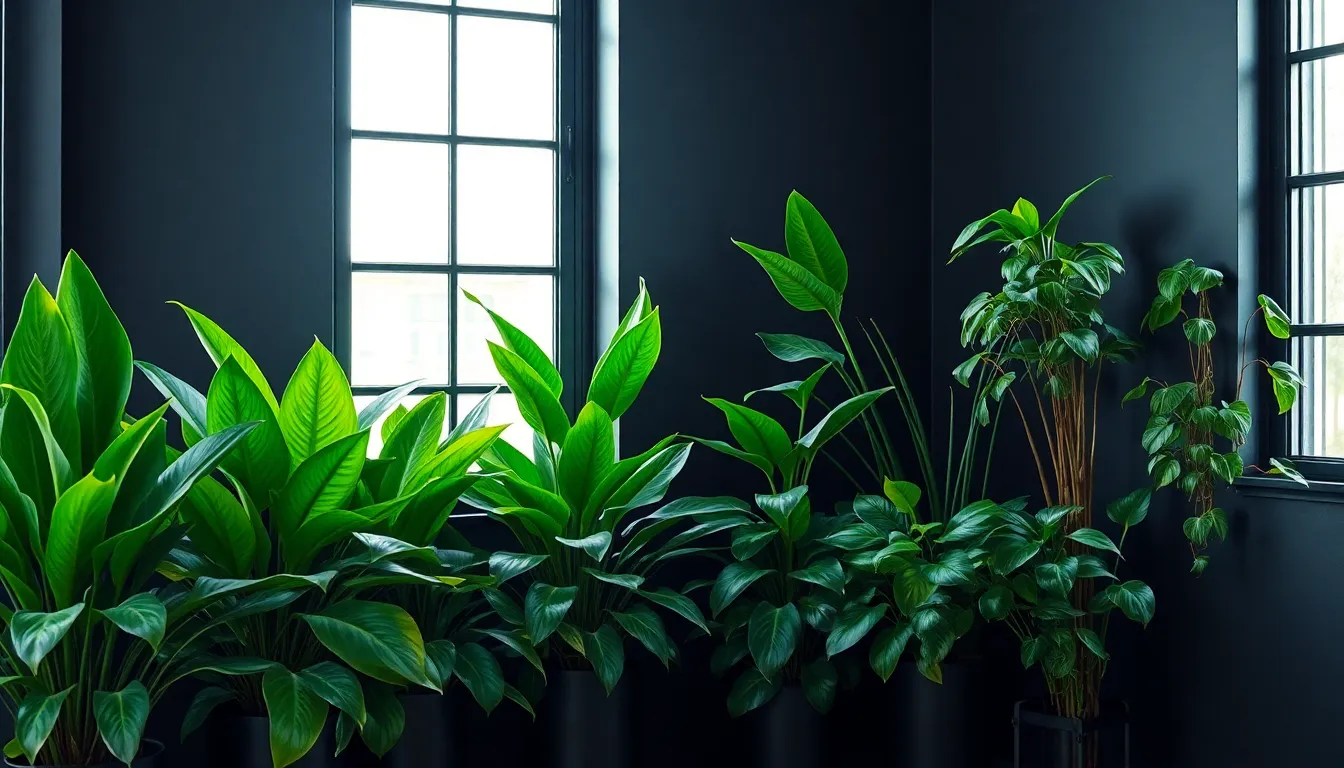
We’ve established our dramatic black foundation, and now it’s time to choose the perfect plants that’ll flourish in these low-light environments. These resilient species don’t require direct sunlight but do need some natural ambient light from windows or doors, which can be supplemented with artificial plant lights when necessary.
Snake Plants for Modern Minimalism
Snake Plants (Sansevieria) deliver the perfect sculptural element for our black room design with their upright, sword-like leaves that create striking vertical lines. We particularly love the ‘Zeylanica’ variety for its hardy nature and exceptional tolerance of very low light conditions. These architectural beauties require minimal watering and actively purify indoor air, making them both functional and stylish additions to dark spaces. Their modern, minimalistic appearance complements the sleek aesthetic of black walls while adding that essential touch of living greenery we’re after.
ZZ Plants for Easy Maintenance
ZZ plants (Zamioculcas zamiifolia) rank among the easiest indoor plants to care for, thriving in low-light environments while tolerating complete neglect. We appreciate their waxy, deep green leaves that add a glossy texture capable of brightening even the darkest corners of our black rooms. These slow-growing but incredibly durable plants adapt perfectly to spaces where light is scarce, making them ideal for anyone wanting beautiful greenery without the maintenance headaches. Their resilient nature means we can focus on enjoying their beauty rather than worrying about complex care routines.
Pothos for Trailing Green Appeal
Pothos plants (Epipremnum aureum) bring versatile trailing beauty that flourishes in low light with minimal fuss from us. We love how their cascading vines can soften harsh corners and add lush, flowing greenery that contrasts beautifully against black walls. These adaptable plants come in variegated varieties that create visual interest even without strong sunlight, allowing us to add texture and movement to our dark spaces. Their ability to trail from shelves or hang from ceiling hooks gives us endless design possibilities for incorporating natural elements throughout our black room sanctuary.
Design Strategic Lighting to Enhance Your Black Room with Plants
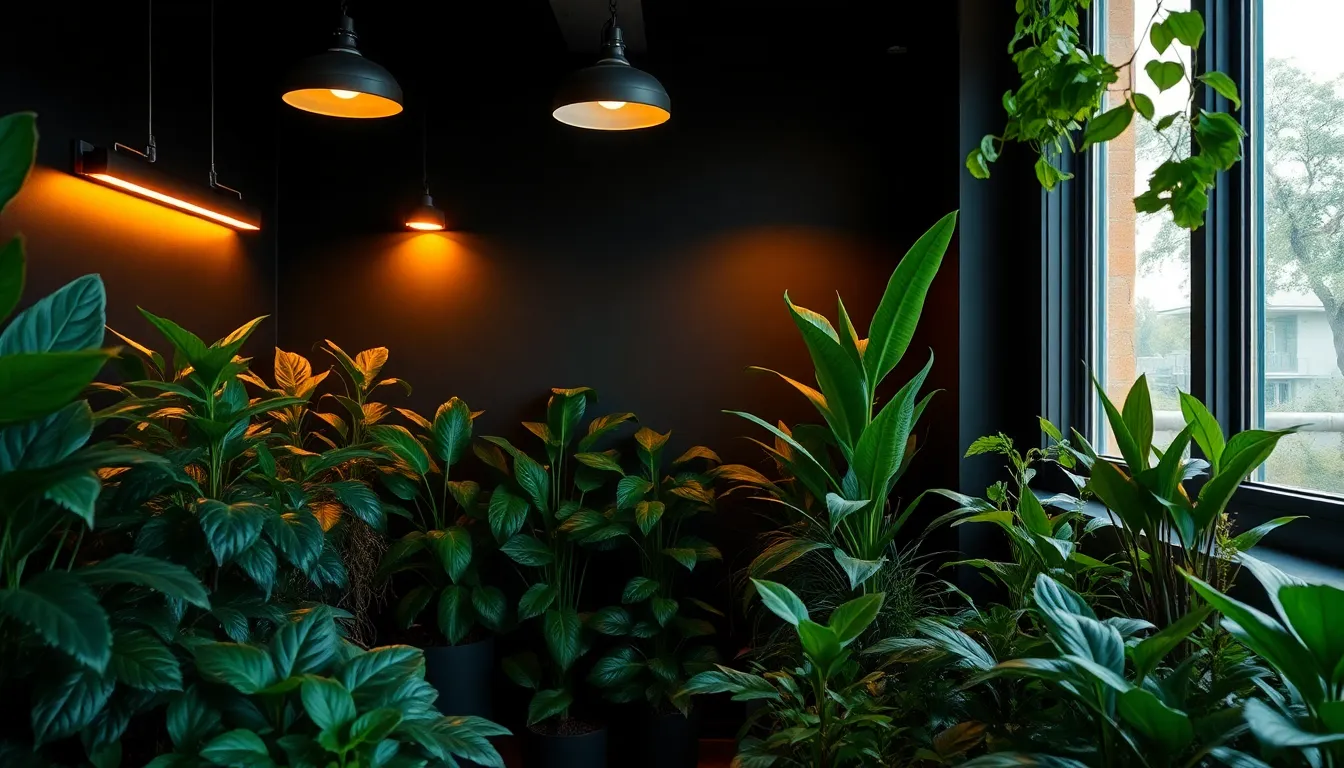
Lighting transforms our black room from merely dramatic to truly functional for both plants and people. We’ll explore three essential lighting strategies that support plant health while maintaining the sophisticated ambiance we’ve created.
Install Grow Lights for Plant Health
Grow lights become essential in our black room environment where natural light may be limited. We recommend modern LED grow lights like the Aspect LED that combine effective plant spectra with stylish home designs, avoiding the industrial appearance of traditional grow lights.
These specialized fixtures provide the full spectrum lighting our plants need to photosynthesize effectively. Most grow lights offer adjustable intensity settings, allowing us to customize light levels for different plant species throughout our space.
Positioning matters significantly with grow lights. We place them 12 to 18 inches above our plants, adjusting height based on each species’ exact requirements. Timer controls help us maintain consistent 12 to 16 hour light cycles that mimic natural daylight patterns.
Quality grow lights support even our low light plants to thrive in darker environments. We’ve found that combining multiple smaller fixtures creates more even light distribution than relying on a single large unit.
Use Warm LED Fixtures for Ambiance
Warm LED fixtures create the cozy atmosphere that makes our black room inviting while highlighting our plant collection. We select fixtures with color temperatures between 2700K and 3000K to enhance the richness of both our dark walls and green foliage.
These ambient lights add depth and moodiness to our space without overpowering the natural beauty of our plants. Strategic placement of warm LEDs creates layered lighting that showcases different textures and forms throughout our room.
Dimmable options give us control over the mood and intensity. We can adjust brightness levels for different times of day or activities, from bright task lighting to subtle evening ambiance.
Wall sconces and table lamps with warm LEDs complement our grow lights perfectly. This combination ensures our plants receive proper growing conditions while maintaining the sophisticated atmosphere we desire.
Incorporate Natural Light Sources
Natural light sources provide the foundation for our black room’s lighting strategy, even when limited. We maximize existing windows and skylights to support our plants’ growth while balancing the room’s dramatic darkness.
Window treatments play a crucial role in controlling natural light flow. We use adjustable blinds or curtains to regulate light intensity throughout the day, preventing our plants from receiving too much direct sunlight that could cause leaf burn.
Skylights offer excellent overhead illumination that mimics natural growing conditions. When possible, we position our larger statement plants beneath these natural light sources to take advantage of optimal growing conditions.
Reflective surfaces help us amplify available natural light. We strategically place mirrors or light colored accessories to bounce light around our space, extending the reach of natural illumination to support more plant locations.
Combining natural light with our supplemental grow lights creates a well rounded lighting strategy. This approach ensures our plants receive consistent light exposure while maintaining the moody aesthetic that makes our black room so captivating.
Choose Plant Containers That Complement Dark Aesthetics
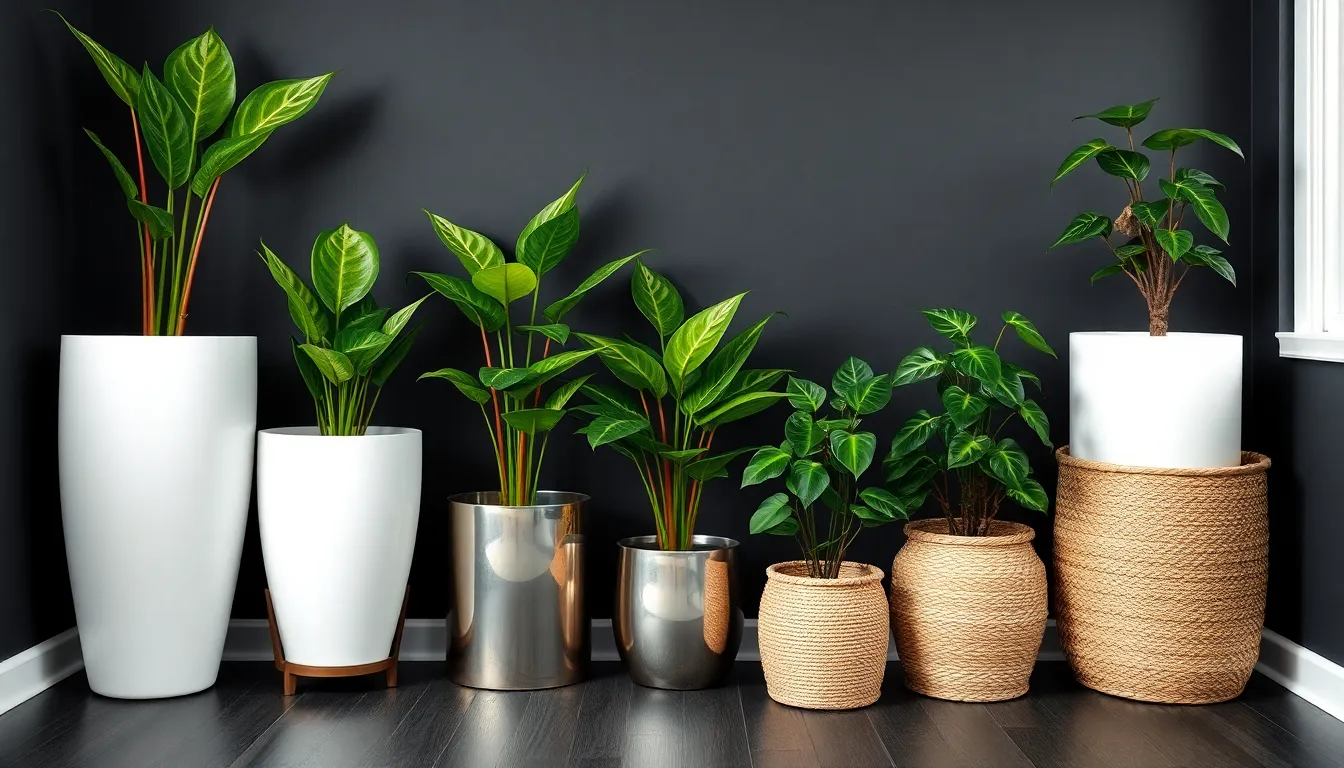
Now that we’ve established our lighting strategy, selecting the right plant containers becomes crucial for maintaining visual harmony in our black room design.
White and Light-Colored Planters for Contrast
White planters create striking visual impact against dark walls, making our plant collections pop with vivid intensity. We recommend choosing crisp white ceramic or glossy white containers to maximize this dramatic effect. Light colored planters brighten the entire space while emphasizing the lush green foliage of our plants.
Modern minimalist interiors benefit most from this sharp contrast approach. Clean lines and bright surfaces provide visual delineation that enhances our room’s contemporary aesthetic. We’ll find that white containers work exceptionally well with architectural plants like Snake Plants or tall Fiddle Leaf Figs.
Metallic Planters for Sophisticated Appeal
Metallic containers in gold, brass, or matte black metal finishes add elegant sophistication to our dark themed spaces. These reflective surfaces provide subtle sheen that breaks up monochrome schemes without overwhelming the design. We can choose from copper planters for warmth or chrome options for cooler tones.
Luxury and industrial styles embrace metallic elements that complement black interiors perfectly. Brushed finishes work better than high polish options to maintain our room’s moody atmosphere. We’ll discover that metallic planters enhance the refined character of our space while adding textural interest.
Natural Woven Baskets for Texture
Woven baskets introduce organic warmth that softens the intensity of our black surroundings. These natural materials create inviting contrast through their tactile qualities and earthy tones. We can select from rattan, seagrass, or jute options to match our preferred aesthetic.
Bohemian and eclectic interiors thrive with basket planters that balance darkness with natural elements. Textured surfaces add visual depth while maintaining our room’s edgy character. We’ll find that baskets work beautifully with trailing plants like Pothos or cascading Boston Ferns that spill over their natural edges.
Arrange Your Plants for Maximum Visual Impact
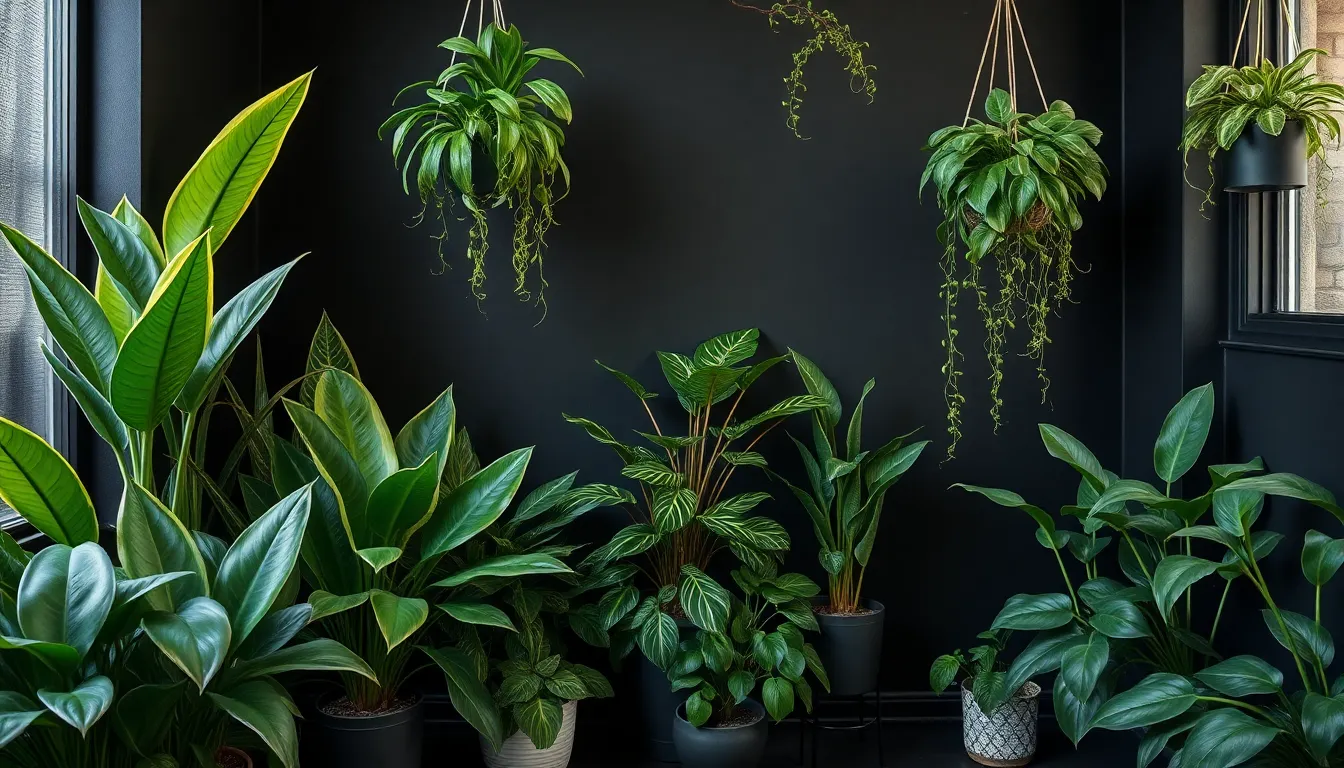
With your containers selected and lighting perfected, we can now focus on creating arrangements that truly showcase your plants against the dramatic black backdrop. The key lies in strategic placement that maximizes visual depth and creates an captivating display.
Create Varying Heights and Levels
Layering plants at different elevations transforms your black room into a ever-changing botanical showcase. Tall plants like snake plants or black raven (Zamioculcas zamiifolia) work perfectly in empty corners, drawing the eye upward while adding architectural interest to your space. We recommend placing these statement pieces first, as they anchor your entire arrangement.
Medium height plants bridge the gap between your floor and ceiling elements, creating smooth visual transitions that guide the eye naturally throughout the room. Smaller plants soften harsh lines and balance the overall composition, preventing any single element from overwhelming your carefully curated space.
Floor to ceiling arrangements maximize the vertical space in your black room. Position your tallest specimens near natural light sources where possible, then cascade down to progressively smaller plants as you move away from windows. This technique creates natural depth while ensuring each plant receives appropriate light levels for optimal growth.
Group Plants in Odd Numbers
Odd numbered clusters create more organic and visually appealing arrangements than even groupings. We consistently use groups of three, five, or seven plants because they naturally appeal to the human eye and feel more balanced in interior spaces. This principle works especially well against black walls where each plant becomes a focal point.
Combining different textures and shapes within your odd numbered groupings prevents monotony. Mix glossy leafed plants like black raven with matte textured options such as snake plants to create visual interest. Vary the leaf shapes too – pair broad leafed specimens with spiky or trailing varieties for maximum contrast against your dark backdrop.
Strategic spacing between your plant clusters maintains visual breathing room. We space our groupings far enough apart that each cluster reads as a distinct element, yet close enough to create cohesive flow throughout the room. This approach works particularly well in black rooms where shadows help define individual plant groupings.
Use Plant Stands and Hanging Options
Elevating plants on stands introduces crucial vertical layers that prevent flat, boring arrangements. We use plant stands of varying heights to create stepped displays that showcase each specimen effectively. Metal stands in brass or matte black finishes complement the sophisticated aesthetic while providing stable platforms for your collection.
Hanging plants maximize your growing space while adding ever-changing movement to static arrangements. Suspend planters at different heights throughout your black room to create interesting shadow patterns and visual depth. Trailing plants like pothos work exceptionally well in hanging configurations, their cascading foliage softening the stark lines of your dark walls.
Combining floor plants, elevated specimens, and hanging options creates the most impactful displays. We recommend using all three elevation techniques in the same space to achieve maximum visual interest. This layered approach works especially well in black rooms where the interplay of light and shadow highlights each plant’s unique form and texture.
Add Complementary Decor Elements to Your Black Plant Room

We’ve established our stunning plant arrangements, but the right decor elements will truly transform your black room into a sophisticated oasis.
Incorporate Mirrors to Reflect Light
Mirrors serve as essential tools in black rooms to bounce light around and prevent the space from feeling too dark or enclosed. We recommend placing mirrors near your plant collections to double the visual impact of greenery and create a lush, expansive feel throughout the room.
Strategic positioning amplifies both natural and artificial light sources while making your space appear larger. Mirrors with sleek black or metallic frames maintain the room’s moody elegance while brightening the space subtly without compromising the dramatic aesthetic.
Consider oversized mirrors on walls opposite windows to maximize light reflection. We’ve found that round mirrors soften the angular lines of furniture while rectangular options complement geometric plant arrangements perfectly.
Choose Light-Colored Furniture and Accessories
Light-colored furniture and accessories balance dark walls and floors by adding contrast and preventing the room from feeling too heavy. We suggest incorporating pieces in whites, creams, or light natural woods to soften the black backdrop and complement your green plant collections beautifully.
Textiles play a crucial role in achieving this balance effectively. Linen or cotton fabrics in light hues on cushions, throws, or bedding provide a fresh, airy feel that contrasts beautifully with black surfaces while maintaining comfort and style.
Natural materials like light oak or birch wood furniture introduce warmth without overwhelming the space. We recommend selecting pieces with clean lines that echo the sleek sophistication of your black walls while providing visual breathing room.
Cream or white ceramic vases, picture frames, and decorative objects create stunning focal points against dark surfaces. These accessories tie together your plant displays and furniture while maintaining the room’s elegant cohesion.
Select Artwork That Enhances the Space
Artwork in a black plant room should amplify the dramatic and organic vibe you’ve carefully cultivated. We recommend choosing floral or nature-inspired prints with black backgrounds to add depth and cohesiveness to your overall design scheme.
Graphic patterns or monochrome artworks introduce modern dynamics without overwhelming your carefully arranged greenery. These pieces create visual interest while maintaining harmony with your plant collections and dark aesthetic foundation.
Botanical prints featuring subtle greens or natural tones tie your plants and decor together effectively. We suggest selecting artwork that incorporates similar color palettes to your plant varieties for a unified, intentional look.
Large scale pieces make bold statements against black walls while smaller groupings create intimate gallery walls. Consider mixing photography, illustrations, and abstract pieces that reflect your personal style while complementing the organic beauty of your plant displays.
Maintain Your Black Room with Plants for Long-Term Success
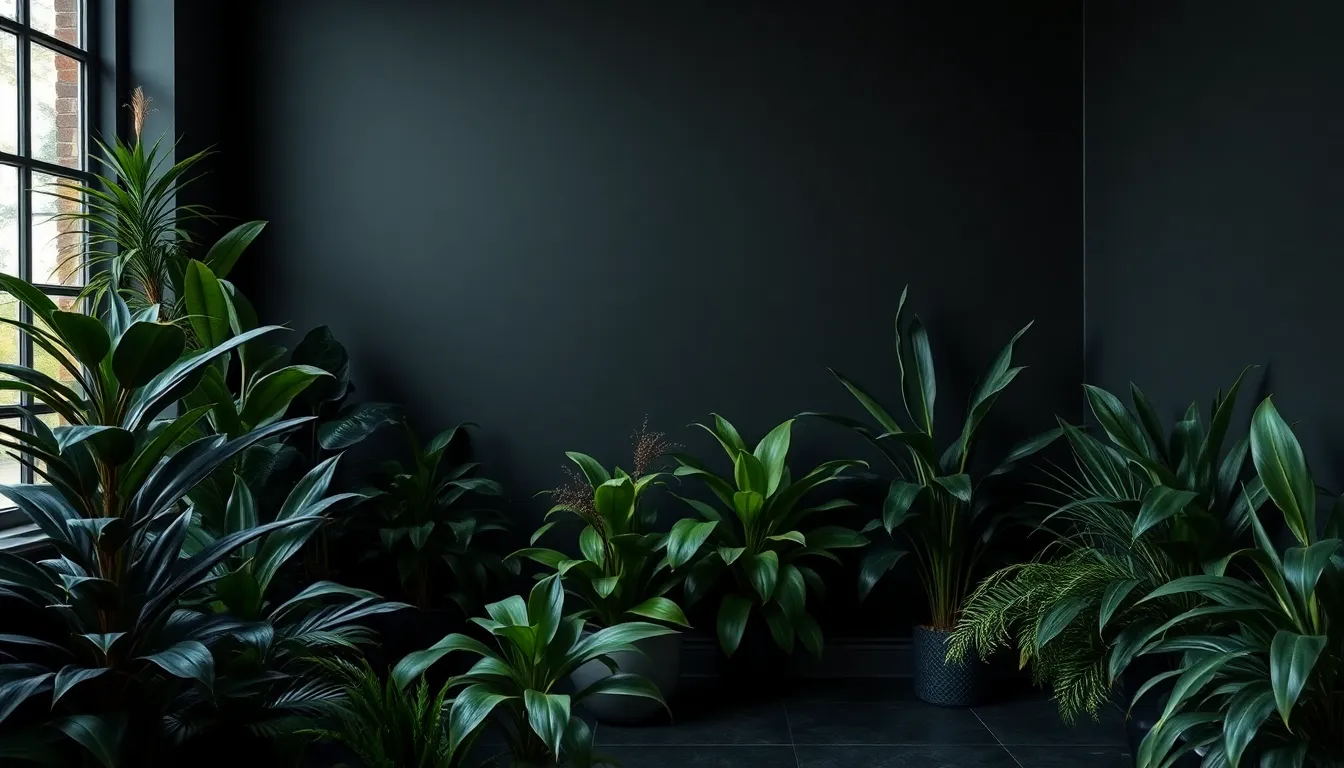
We’ve created our stunning black sanctuary with carefully chosen plants, but proper maintenance ensures this dramatic space continues to thrive. Consistent care practices will keep our dark botanical haven looking exceptional for years to come.
Establish a Consistent Watering Schedule
Timing becomes crucial when caring for plants in our black themed environments. Most black foliage plants like the Black ZZ Plant and Black Mondo Grass require careful water management, with the top inch of soil needing to dry completely before the next watering session. Overwatering presents the biggest threat to these drought tolerant specimens, especially in the lower light conditions typical of our dark rooms.
Frequency should decrease rather than increase for optimal plant health. Black plants often tolerate less frequent watering sessions, making them ideal for busy lifestyles while reducing the risk of root rot. Water thoroughly but infrequently to encourage strong root development and prevent the waterlogged conditions that damage these resilient species.
Monitor Plant Health in Low-Light Conditions
Assessment of plant vitality requires regular observation in our dramatically lit spaces. Many black plants need at least partial shade or indirect bright light to maintain their deep coloration and vigorous growth patterns. Signs of fading color or stunted growth indicate inadequate lighting conditions that require immediate attention.
Rotation ensures even light distribution across all plant surfaces. Turn pots regularly to promote balanced growth and prevent plants from leaning toward available light sources. Strategic repositioning helps maintain the symmetrical appearance that enhances our black room’s sophisticated aesthetic.
Clean and Dust Regularly for Optimal Appearance
Dust accumulation shows more prominently on dark foliage surfaces. Gently wipe leaves with a soft, damp cloth every few weeks to remove dust particles that can block photosynthesis and dull the glossy appearance of specimens like the Black Beauty Plant. Regular cleaning maintains the dramatic visual impact that makes these plants so striking against our dark walls.
Pruning maintains both health and appearance standards. Remove dead or damaged leaves promptly to improve air circulation and encourage fresh growth throughout the plant structure. This practice keeps plants like the Black Beauty Plant looking elegant while preventing potential disease issues that could spread to healthy foliage.
Conclusion
We’ve shown you how groundbreaking a black room with plants can be for your home’s aesthetic. The dramatic contrast between dark walls and vibrant greenery creates an atmosphere that’s both sophisticated and naturally inviting.
With the right plant selection low-light maintenance routine and thoughtful decor choices you’ll have a stunning space that serves as your personal retreat. Remember that success lies in balancing the bold darkness with strategic lighting and carefully chosen accessories.
Your black plant room will become more than just another living space – it’ll be a conversation starter that reflects your unique design vision. Start with one accent wall and watch as this striking combination transforms your entire home’s energy.
Frequently Asked Questions
What are the best paint colors for creating a black room backdrop?
Benjamin Moore’s Black Beauty and Sherwin Williams’ Tricorn Black are excellent choices for creating dramatic black walls. Choose matte finishes to absorb light and reduce glare. Consider cool-toned blacks for silver and blue-green foliage, while warm blacks complement golden and yellow-green plants perfectly.
Which plants thrive best in black rooms with low light?
Snake Plants, ZZ Plants, and Pothos are ideal for black rooms as they require minimal sunlight and are extremely resilient. These low-light tolerant species not only survive but thrive in darker environments, making them perfect companions for your dramatic black wall backdrop.
How should I light a black room with plants?
Install modern LED grow lights with adjustable intensity settings to support plant health. Use warm LED fixtures to create a cozy atmosphere while highlighting your plant collection. Maximize natural light through strategic window treatments and incorporate reflective surfaces to enhance brightness.
What type of planters work best in black rooms?
White and light-colored planters create striking contrast against dark walls. Metallic planters in gold, brass, or matte black finishes add sophisticated appeal. Natural woven baskets introduce texture and warmth, softening the intensity of black surroundings while maintaining the aesthetic balance.
How do I arrange plants for maximum visual impact?
Create varying heights by layering plants using tall specimens as anchors, then fill gaps with medium and smaller plants. Group plants in odd numbers for an organic look. Combine different textures and shapes, and incorporate plant stands and hanging options for vertical interest.
Should I paint an accent wall or the entire room black?
Accent walls are recommended for beginners as they’re easier to balance and less overwhelming. Full room coverage creates maximum dramatic impact but works best in well-lit spaces. Consider your room’s natural light sources and size when making this decision.
What decor elements complement black plant rooms?
Incorporate mirrors with sleek black or metallic frames to reflect light and create spaciousness. Add light-colored furniture and textiles for balance. Choose nature-inspired artwork or floral prints that align with your plant displays while maintaining the room’s sophisticated aesthetic.
How do I maintain plants in a black room?
Establish consistent watering schedules, especially for drought-tolerant species that are prone to overwatering. Monitor plant health regularly in low-light conditions and rotate pots for even light distribution. Clean plants regularly and prune as needed to promote healthy growth.

